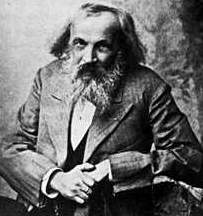Dmitri Mendeleev
 Dmitri Ivanovich
Mendeleev (Russian
(February 7, 1834 - January 20, 1907) was a Russian chemist who became known as
one of two scientists who created the first version of the Periodic Table of Elements.
He stated that the elements were arranged in a pattern which allowed him to predict
the properties of elements yet to be discovered.
Dmitri Ivanovich
Mendeleev (Russian
(February 7, 1834 - January 20, 1907) was a Russian chemist who became known as
one of two scientists who created the first version of the Periodic Table of Elements.
He stated that the elements were arranged in a pattern which allowed him to predict
the properties of elements yet to be discovered.
Mendeleev was born in Tobolsk, Siberia, the youngest of fourteen children of Maria Dmitrievna Korniliev and Ivan Pavlovitch Mendeleev. At the age of fourteen, after the death of his father, Mendeleev attended the Gymnasium in Tobolsk. In 1849, the now poor family Mendeleev relocated to St. Petersburg, where he entered the university in 1850. After graduating, an illness that was diagnosed as tuberculosis caused him to move to the Crimean Peninsula near the Black Sea in 1855, where he became chief science master of the local gymnasium. He returned with fully restored health to St. Petersburg in 1856.
Between 1859 and 1861 he worked on the density of gases in Paris, and the workings of the spectroscope with Gustav Robert Kirchhoff in Heidelberg. In 1863, after returning to Russia, he became Professor of Chemistry at the Technological Institute and the University of St. Petersburg.
In 1866, Newlands published his Law of Octaves. Mendeleev had been working on a similar idea, and on March 6, 1869, a formal presentation was made to the Russian Chemical Society, entitled The Dependence Between the Properties of the Atomic Weights of the Elements, stating:
- The elements, if arranged according to their atomic weights, exhibit an apparent periodicity of properties.
- Elements which are similar as regards their chemical properties have atomic weights which are either of nearly the same value (e.g., Pt, Ir, Os) or which increase regularly (e.g., K, Rb, Cs).
- The arrangement of the elements, or of groups of elements in the order of their atomic weights, corresponds to their so-called valencies, as well as, to some extent, to their distinctive chemical properties; as is apparent among other series in that of Li, Be, Ba, C, N, O, and Sn.
- The elements which are the most widely diffused have small atomic weights.
- The magnitude of the atomic weight determines the character of the element, just as the magnitude of the molecule determines the character of a compound body.
- We must expect the discovery of many as yet unknown elements-for example, elements analogous to aluminum and silicon- whose atomic weight would be between 65 and 75.
- The atomic weight of an element may sometimes be amended by a knowledge of those of its contiguous elements. Thus the atomic weight of tellurium must lie between 123 and 126, and cannot be 128.
- Certain characteristic properties of elements can be foretold from their atomic weights.
Unknown to Mendeleev, Lothar Meyer was working on a virtually identical periodic table though Meyer never came to the idea of predicting new elements and correcting atomic weights. Meyer and Mendeleev can be considered the co-creators of this table.
Though Mendeleev was widely honored by scientific organizations all over Europe, his political activities worried the Russian government, which led to his resignation from St. Petersburg University on August 17, 1890. In 1893, he was appointed Director of the Bureau of Weights and Measures.
Mendeleev is also credited for scientifical justification of the "optimal" ratio of alcohol of 40%(80 proof) used in Russian vodka.
He died in St. Petersburg, Russia. Element 101 is named after him.
External links
- More about Mendeleev
- Portrait of Mendeleev (1885) by Russia's most famous painter Ilya Repin
- Picture of Mendeleev - Edgar Fahs Smith Collection, University of Pennsylvania
- Original Periodic Table - annotated
- Mendeleev's first draft version of the Periodic Table - 17 February 1869
- Mendeleev was invited in 1889 to give the yearly Faraday Lecture. He used the occasion to display his new insights:
- Faraday Lecture - July 4, 1889 - annotated
